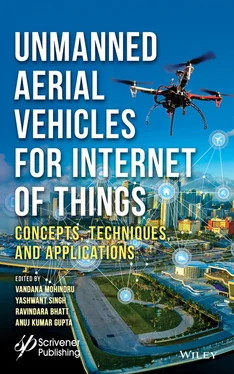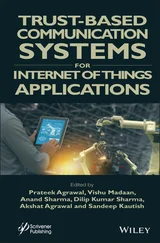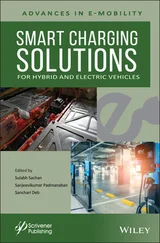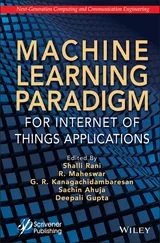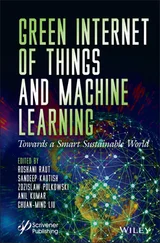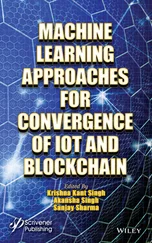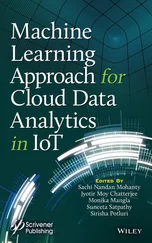1 Cover
2 Title page
3 Copyright
4 Preface
5 1 Unmanned Aerial Vehicle (UAV): A Comprehensive Survey 1.1 Introduction 1.2 Related Work 1.3 UAV Technology 1.4 Application of UAV 1.5 UAV Challenges 1.6 Conclusion and Future Scope References
6 2 Unmanned Aerial Vehicles: State-of-the-Art, Challenges and Future Scope 2.1 Introduction 2.2 Technical Challenges 2.3 Conclusion References
7 3 Battery and Energy Management in UAV-Based Networks 3.1 Introduction 3.2 The Need for Energy Management in UAV-Based Communication Networks 3.3 Efficient Battery and Energy Management Proposed Techniques in Literature 3.4 Conclusion References
8 4 Energy Efficient Communication Methods for Unmanned Ariel Vehicles (UAVs): Last Five Years’ Study 4.1 Introduction 4.2 Literature Survey Process 4.3 Routing in UAV 4.4 Challenges and Issues 4.5 Conclusion References
9 5 A Review on Challenges and Threats to Unmanned Aerial Vehicles (UAVs) 5.1 Introduction 5.2 Applications of UAVs and Their Market Opportunity 5.3 Attacks and Solutions to Unmanned Aerial Vehicles (UAVs) 5.4 Research Challenges 5.5 Conclusion References
10 6 Internet of Things and UAV: An Interoperability Perspective 6.1 Introduction 6.2 Background 6.3 Internet of Things (IoT) and UAV 6.4 Applications of UAV-Enabled IoT 6.5 Research Issues in UAV-Enabled IoT 6.6 High-Level UAV-Based IoT Architecture 6.7 Interoperability Issues in UAV-Based IoT 6.8 Conclusion References
11 7 Practices of Unmanned Aerial Vehicle (UAV) for Security Intelligence 7.1 Introduction 7.2 Military 7.3 Attack 7.4 Journalism 7.5 Search and Rescue 7.6 Disaster Relief 7.7 Conclusion References
12 8 Blockchain-Based Solutions for Various Security Issues in UAV-Enabled IoT 8.1 Introduction 8.2 Introduction to UAV and IoT 8.3 Security and Privacy Issues in UAV-Enabled IoT 8.4 Blockchain-Based Solutions to Various Security Issues 8.5 Research Directions 8.6 Conclusion 8.7 Future Work References
13 9 Efficient Energy Management Systems in UAV-Based IoT Networks 9.1 Introduction 9.2 Energy Harvesting Methods 9.3 Energy Recharge Methods 9.4 Efficient Energy Utilization Methods 9.5 Conclusion References
14 10 A Survey on IoE-Enabled Unmanned Aerial Vehicles 10.1 Introduction 10.2 Overview of Internet of Everything 10.3 Overview of Unmanned Aerial Vehicle (UAV) 10.4 UAV and IoE Integration 10.5 Open Research Issues 10.6 Discussion 10.7 Conclusion References
15 11 Role of AI and Big Data Analytics in UAV-Enabled IoT Applications for Smart Cities 11.1 Introduction 11.2 Overview of UAV-Enabled IoT Systems 11.3 Overview of Big Data Analytics 11.4 Big Data Analytics Requirements in UAV-Enabled IoT Systems 11.5 Challenges 11.6 Conclusion 11.7 Future Work References
16 12 Design and Development of Modular and Multifunctional UAV with Amphibious Landing, Processing and Surround Sense Module 12.1 Introduction 12.2 Existing System 12.3 Proposed System 12.4 IoT Sensors and Architecture 12.5 Advantages of the Proposed System 12.6 Design 12.7 Results 12.8 Conclusion 12.9 Future Scope References
17 13 Mind-Controlled Unmanned Aerial Vehicle (UAV) Using Brain–Computer Interface (BCI) 13.1 Introduction 13.2 Mind-Controlled UAV With BCI Technology 13.3 Layout and Architecture of BCI Technology 13.4 Hardware Components 13.5 Software Components 13.6 Hardware and Software Integration 13.7 Conclusion References
18 14 Precision Agriculture With Technologies for Smart Farming Towards Agriculture 5.0 14.1 Introduction 14.2 Drone Technology as an Instrument for Increasing Farm Productivity 14.3 Mapping and Tracking of Rice Farm Areas With Information and Communication Technology (ICT) and Remote Sensing Technology 14.4 Strong Intelligence From UAV to the Agricultural Sector 14.5 Drones-Based Sensor Platforms 14.6 Jobs of Space Technology in Crop Insurance 14.7 The Institutionalization of Drone Imaging Technologies in Agriculture for Disaster Managing Risk 14.8 Usage of Internet of Things in Agriculture and Use of Unmanned Aerial Vehicles 14.9 Conclusion References
19 15 IoT-Based UAV Platform Revolutionized in Smart Healthcare 15.1 Introduction 15.2 IoT-Based UAV Platform for Emergency Services 15.3 Healthcare Internet of Things: Technologies, Advantages 15.4 Healthcare’s IoT Applications: Surgical and Medical Applications of Drones 15.5 Drones That Will Revolutionize Healthcare 15.6 Healthcare Revolutionizing Drones 15.7 Conclusion References
20 Index
21 End User License Agreement
1 Cover
2 Table of Contents
3 Title page
4 Copyright
5 Preface
6 Begin Reading
7 Index
8 End User License Agreement
1 Chapter 1Figure 1.1 Fixed-wing UAVs [33].Figure 1.2 Single rotor drone [35].Figure 1.3 Types of multi-rotor drones [34].Figure 1.4 V-22 osprey military helicopter [36].Figure 1.5 RQ-11B Raven Small UAS (SUAS) [3, 37].Figure 1.6 RQ-4 Global Hawk—Heavy Strategic Military Drone [38].Figure 1.7 Representation of GUI configuration of ArduPilot open-source platform...Figure 1.8 Visual representation of a fixed-Wing platform taking photographs at ...Figure 1.9 VLoS deployment scenario for UAS [40].Figure 1.10 BLoS deployment scenario for UAS [40].
2 Chapter 2Figure 2.1 Design issues of UAV-assisted communication networks.
3 Chapter 3Figure 3.1 Challenges faced by UAVs-based networks.Figure 3.2 Solutions for battery & energy management in UAV-based networks.
4 Chapter 4Figure 4.1 Single hop communication.Figure 4.2 Multi-hop communication.
5 Chapter 5Figure 5.1 UAVs usage in various applications [12].Figure 5.2 Addressable market value of UAVs (in billions).
6 Chapter 6Figure 6.1 UAV opportunities for IoT [11].Figure 6.2 Research Issues in UAV-enabled IoT [4].Figure 6.3 High-level UAV-based IoT architecture [23].Figure 6.4 Interoperability issues in UAV based IoT [10].
7 Chapter 7Figure 7.1 Unmanned or crewless aerial vehicle system.Figure 7.2 Classification of UAV.Figure 7.3 Survey by drone.
8 Chapter 8Figure 8.1 Some of the civil applications of UAV.Figure 8.2 Some of the applications of IoT.Figure 8.3 Layered architecture of IoT.Figure 8.4 Some of the applications of UAV-enabled IoT.Figure 8.5 Architecture: High level view of UAV-enabled IoT system with heteroge...Figure 8.6 Chain of blocks and block details in blockchain.Figure 8.7 Enlarged attack space of UAV and IoT integration.Figure 8.8 Security issues in UAV-enabled IoT.
9 Chapter 9Figure 9.1 UAV-assisted IoT architecture [5].Figure 9.2 Energy harvesting mechanisms [2].Figure 9.3 Energy trading mechanism.Figure 9.4 Flowchart for CFS mechanism.
10 Chapter 10Figure 10.1 Three expectations of IoE.Figure 10.2 IoE scalability enhancing communication technologies.
11 Chapter 11Figure 11.1 Application domains of UAV-enabled IoT.Figure 11.2 Applications of UAV-enabled IoT for smart cities.Figure 11.3 Layered architecture for UAV-enabled IoT big data analytics.Figure 11.4 Applications of intelligent big data analytics for governance and ma...
12 Chapter 12Figure 12.1 3-layer IoT architecture.Figure 12.2 5-layer IoT architecture.Figure 12.3 Block diagram of system of modules.Figure 12.4 Flowchart of system design.Figure 12.5 Lateral view of the 3D design of the amphibious model.Figure 12.6 Top view of the 3D design of the amphibious model.Figure 12.7 Design of processing module.Figure 12.8 Design of surround sense module.Figure 12.9 Final view of UAV with both processing and surround sense modules at...Figure 12.10 Data collected by surround sense module represented graphically.Figure 12.11 Graph of calculated AQI values by the surround sense module.
13 Chapter 13Figure 13.1 Layout of BCI technology.Figure 13.2 Neurosky mindwave headset.Figure 13.3 Arduino MKR 1000.Figure 13.4 Laptop computer.Figure 13.5 Quadcopter drone.Figure 13.6 Processing P3 Software Window.Figure 13.7 Arduino IDE Software Window.Figure 13.8 Hardware connectivity diagram.Figure 13.9 Data transmission diagram.
Читать дальше
